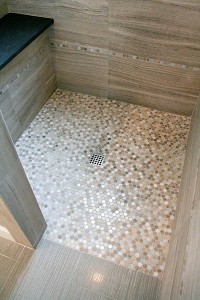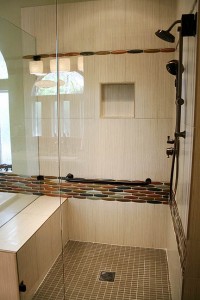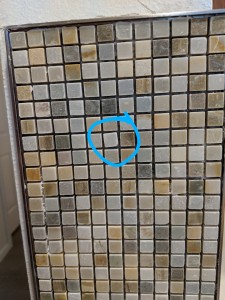Many a bathroom remodel starts with an unwelcome need to repair something major, like a shower pan that is leaking, or as with a current client here in Austin, her cast iron bathroom in her cute little French Place bungalow is threatening to fall through her pier and beam foundation. If a contractor is going to take a crowbar to your shower floor or your vintage bathtub, chances are overwhelmingly high that your flooring is going to get wrecked, at least in that immediate vicinity. That’s where the snowball starts gathering steam…first, you’re looking at new tile flooring. Then you think to yourself, if I’m going to have a contractor in here anyway (especially during a pandemic), I might as well update that old vanity light fixture. And repaint the walls. And while we’re at it, I’ve always hated the tile on the walls around the tub/shower or that outdated vanity cabinet. Before too much longer, that one repair job turns into a gut renovation of your bathroom, or at least some sort of cosmetic overhaul.
This is how we turn lemons into lemonade. Really expensive, but deeply gratifying lemonade.
Top 5 Tips for Remodeling Your Bathroom
1. If you’re tiling your shower floor, use smaller-sized tile—nothing larger than 4″x4″.
Why? In most instances, your shower drain is going to be located somewhere in the center of your shower floor. In order for your shower to drain efficiently, you need a gentle slope toward the location of your shower drain…and if you’re using large-scale tile on the shower floor, it would require cutting it into irregular triangle shapes surrounding the drain. Think about the last time you visited a public bathroom, and unless that business or office sprang for smaller tile on the floor, you’ve seen plenty of examples of this, and I’m sure none of them were particularly attractive. You can disguise your slope a lot better and fool the eye by using smaller tile that allows for more frequent grout breaks, and thus, gives you the optical illusion of a level floor.

Marble penny tiles disguise the slope to the drain in this client’s bathroom.

Any shape of tile can be used on a shower floor, as long as it is small scale.
2. Ask your designer to inspect your tile design—after the tile has been laid, but before it has been grouted.
At this critical juncture in your bathroom remodel journey, you can still tweak any major flaws that might be found in the setting of the tile, with as little muss and fuss as possible. I was able to catch this one tiny tile that somehow slipped out of alignment before it was grouted, and because it was easily fixed, my client didn’t experience years of irritation from seeing this flaw front and center on the most noticeable part of her kitchen backsplash:

While mosaic tile like this modern slate kitchen backsplash come on some sort of backing material to keep the tiles straight, sometimes one little bugger can get loose after installation, even when using the best of tilesetters!
3. You don’t always need to keep a tub in your bathroom!
If you are one of those people (or live with one of those people) who really love their baths and use their bathtubs regularly, you can skip on down to the next tip on my list. I won’t encourage anyone to give up anything related to joy, relaxation, or self care. But for the rest of us who would rather just have a kick-ass shower in our owner’s suite bathroom, I’m here to tell you, you may be able to delete those tub-related line items from your bathroom remodeling budget!
Garden tubs, whirlpool tubs, and soaking tubs in general, are both a blessing and a curse when it comes to bathroom renovation projects. They command a huge portion of your materials budget, they take up a lot of square footage, and in the case of bathtubs with whirlpool jets, they require routine maintenance to keep them running efficiently and mold-free. One bathtub in the home is good for resale value (families want a place to bathe their littles), so if you have a tub elsewhere in your house, feel free to ditch the tub and create the shower of your dreams! Find more tips for going tub-free while maintaining resale value in this blog post I wrote a hundred years ago.
4. Opt for mildew-resistant paint on bathroom walls, with an eggshell finish.
Mildew-resistant paint can give you a little bit of grace in a humid space, and since you seldom require endless gallons of paint to cover the walls in the average bathroom, it’s a tiny bump in the budget that can save your bacon later.
Eggshell finish has an almost imperceptible sheen to it, but has enough of surface slickness to keep moisture from permeating through the paint layer. Ages ago, I lived in a cheap rental with flat paint on the walls and sucky ventilation. Over time, you could see drip marks where moisture had consistently ran down the walls—and taken the paint with it!
5. Don’t install tile all the way to the ceiling of your shower or tub surround.
I know, this one is another shocker for most people, because so many upgraded new construction owner’s suites feature tub and shower surrounds that are tiled all the way to the ceiling. But when you’re remodeling a bathroom—especially when embarking on a bathroom renovation in an older home—you run the risk of revealing potential flaws in the framework of your bathroom. Many clients who’ve remodeled their bathroom have discovered that their ceilings aren’t level, and when you put tile on the wall, those tiles and their grout lines can reveal irregularities in the ceiling level if they run all the way up. Instead, if you stop short of the ceiling by 4″-6″ it is easier to disguise these flaws.
If you’re an Austinite considering a bathroom remodel, let Room Fu guide you through the process of selecting your new finishes! To get started, call or text us at 512-797-5821.
